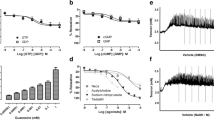Abstract
Carbon monoxide has been proposed as a possible neurotransmitter because of its ability to bind to the iron atom of the heme of guanylyl cyclase, which is similar to that of nitric oxide. To determine whether carbon monoxide exerts an effect on the penis, strips of rabbit corpus cavernosum were mounted in an organ bath for isometric tension studies and the effect of zinc deuteroporphyrin, an inhibitor of heme oxygenase which metabolizes hemoprotein and releases carbon monoxide, on relaxation induced by electrical field stimulation (neurally mediated) was determined. Also observed was relaxation induced by electrical field stimulation after incubation with atropine and guanethidine to isolate nonadrenergic noncholinergic neurotransmission. Zinc deuteroporphyrin (10-6M, 10-5M, 10-4M and 3x10-4M) did not affect relaxation induced by electrical field stimulation in the absence or presence of guanethidine and atropine. Therefore, it appears that carbon monoxide does not contribute to neurally mediated relaxation of the rabbit corpus cavernosum.
Similar content being viewed by others
References
Brock G, Nunes L, Padma-Nathan H, Boyd S, Lue TF (1993) Nitric oxide synthase: a new diagnostic tool for neurogenic impotence. Urology 42:412
Burnett AL, Lowenstein CJ, Bredt DS, Chang TGK, Snyder SH (1992) Nitric oxide: a physiologic mediator of penile erection. Science 257:401
Gräser T, Vedernikov YE, Li DS (1990) Studies on the mechanism of carbon monoxide induced endothelium-independent relaxation in the porcine coronary artery and vein. Biomed Biochim Acta 49:293
Lin H, McGrath JJ (1988) Carbon monoxide effects on calcium levels in vascular smooth muscle. Life Sci 43:1813
Lowensein CJ, Snyder SH (1992) Nitric oxide, a novel biologic messenger. Cell 70:705
Mansouri A, Perry CA (1982) Alteration of platelet aggregation by cigarette smoke and carbon monoxide. Thromb Haemost 48:286
Marks GS, Brien JF, Nakatsu K, McLaughlin BE (1991) Does carbon monoxide have a physiological function? Trends Pharmacol Sci 12:185
McFaul SJ, McGrath JJ (1987) Studies on the mechanism of carbon monoxide-induced vasodilation in the isolated perfused rat heart. Toxicol Appl Pharmacol 87:464
Ramos KS, Lin H, McGrath JJ (1989) Modulation of cyclic guanosine monophosphate levels in cultured aortic smooth muscle cells by carbon monoxide. Biochem Pharmacol 38:1368
Rattan S, Chakder S (1993) Inhibitor effect of CO on internal anal sphincter: heme oxygenase inhibitor inhibits NANC relaxation. Am J Physiol 265:G799
Vedernikov YE, Gräser T, Vanin AF (1989) Similar endothelium-independent arterial relaxation by carbon monoxide and nitric oxide. Biomed Biochim Acta 48:601
Wolff DG, Bidlack WR (1976) The formation of carbon monoxide during peroxidation of microsomal lipids. Biochem Biophys Res Commun 73:850
Zhuo M, Small SA, Kandel ER, Hawkins RD (1993) Nitric oxide and carbon monoxide produce activity-dependent long-term synaptic enhancement in hippocampus. Science 260:1946
Author information
Authors and Affiliations
Rights and permissions
About this article
Cite this article
Kim, Y.C., Davies, M.G., Marson, L. et al. Lack of effect of carbon monoxide inhibitor on relaxation induced by electrical field stimulation in corpus cavernosum. Urol. Res. 22, 291–293 (1994). https://doi.org/10.1007/BF00297197
Received:
Accepted:
Issue Date:
DOI: https://doi.org/10.1007/BF00297197




